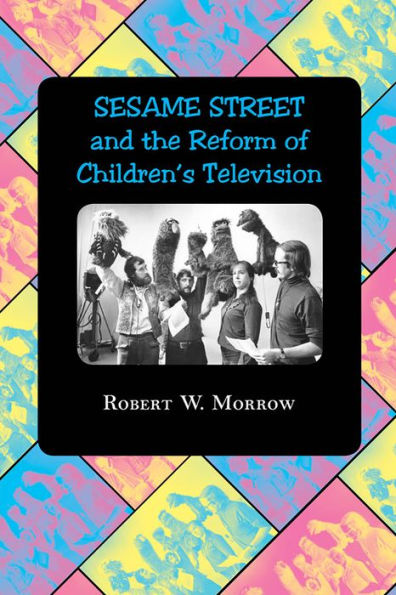"[An] accessible, well-researched introduction to the people and principles behind the show's creation . . . Essential." —Choice (An Outstanding Academic Title of the Year)
By the late 1960s more than a few critics of American culture groused about the condition of television programming and, in particular, the quality and content of television shows for children. In the eyes of the reform-minded, commercial television crassly exploited young viewers; its violence and tastelessness served no higher purpose than the bottom line.
The Children's Television Workshop (CTW)—and its fresh approach to writing and producing programs for kids—emerged from this growing concern. Sesame Street—CTW's flagship hour-long show—aimed to demonstrate how television could help all preschoolers, including low-income urban children, prepare for first grade. In this engaging study Robert W. Morrow explores the origins and inner workings of CTW, how the workshop in New York scripted and designed Sesame Street, and how the show became both a model for network television and a thorn in its side.
Through extensive archival research and a systematic study of sample programs from Sesame Street's first ten seasons, Morrow tells the story of Sesame Street's creation; the ideas, techniques, organization, and funding behind it; its place in public discourse; and its ultimate and unfortunate failure as an agent of commercial television reform.
"An insightful look at American children's television." —Library Journal
1100638655
By the late 1960s more than a few critics of American culture groused about the condition of television programming and, in particular, the quality and content of television shows for children. In the eyes of the reform-minded, commercial television crassly exploited young viewers; its violence and tastelessness served no higher purpose than the bottom line.
The Children's Television Workshop (CTW)—and its fresh approach to writing and producing programs for kids—emerged from this growing concern. Sesame Street—CTW's flagship hour-long show—aimed to demonstrate how television could help all preschoolers, including low-income urban children, prepare for first grade. In this engaging study Robert W. Morrow explores the origins and inner workings of CTW, how the workshop in New York scripted and designed Sesame Street, and how the show became both a model for network television and a thorn in its side.
Through extensive archival research and a systematic study of sample programs from Sesame Street's first ten seasons, Morrow tells the story of Sesame Street's creation; the ideas, techniques, organization, and funding behind it; its place in public discourse; and its ultimate and unfortunate failure as an agent of commercial television reform.
"An insightful look at American children's television." —Library Journal
"Sesame Street" and the Reform of Children's Television
"[An] accessible, well-researched introduction to the people and principles behind the show's creation . . . Essential." —Choice (An Outstanding Academic Title of the Year)
By the late 1960s more than a few critics of American culture groused about the condition of television programming and, in particular, the quality and content of television shows for children. In the eyes of the reform-minded, commercial television crassly exploited young viewers; its violence and tastelessness served no higher purpose than the bottom line.
The Children's Television Workshop (CTW)—and its fresh approach to writing and producing programs for kids—emerged from this growing concern. Sesame Street—CTW's flagship hour-long show—aimed to demonstrate how television could help all preschoolers, including low-income urban children, prepare for first grade. In this engaging study Robert W. Morrow explores the origins and inner workings of CTW, how the workshop in New York scripted and designed Sesame Street, and how the show became both a model for network television and a thorn in its side.
Through extensive archival research and a systematic study of sample programs from Sesame Street's first ten seasons, Morrow tells the story of Sesame Street's creation; the ideas, techniques, organization, and funding behind it; its place in public discourse; and its ultimate and unfortunate failure as an agent of commercial television reform.
"An insightful look at American children's television." —Library Journal
By the late 1960s more than a few critics of American culture groused about the condition of television programming and, in particular, the quality and content of television shows for children. In the eyes of the reform-minded, commercial television crassly exploited young viewers; its violence and tastelessness served no higher purpose than the bottom line.
The Children's Television Workshop (CTW)—and its fresh approach to writing and producing programs for kids—emerged from this growing concern. Sesame Street—CTW's flagship hour-long show—aimed to demonstrate how television could help all preschoolers, including low-income urban children, prepare for first grade. In this engaging study Robert W. Morrow explores the origins and inner workings of CTW, how the workshop in New York scripted and designed Sesame Street, and how the show became both a model for network television and a thorn in its side.
Through extensive archival research and a systematic study of sample programs from Sesame Street's first ten seasons, Morrow tells the story of Sesame Street's creation; the ideas, techniques, organization, and funding behind it; its place in public discourse; and its ultimate and unfortunate failure as an agent of commercial television reform.
"An insightful look at American children's television." —Library Journal
2.99
In Stock
5
1

"Sesame Street" and the Reform of Children's Television
328
"Sesame Street" and the Reform of Children's Television
328eBook
$2.99
$17.99
Save 83%
Current price is $2.99, Original price is $17.99. You Save 83%.
Related collections and offers
2.99
In Stock

Product Details
| ISBN-13: | 9781421407104 |
|---|---|
| Publisher: | Johns Hopkins University Press |
| Publication date: | 02/03/2022 |
| Sold by: | Barnes & Noble |
| Format: | eBook |
| Pages: | 328 |
| File size: | 4 MB |
| Age Range: | 18 Years |
About the Author
What People are Saying About This
From the B&N Reads Blog
